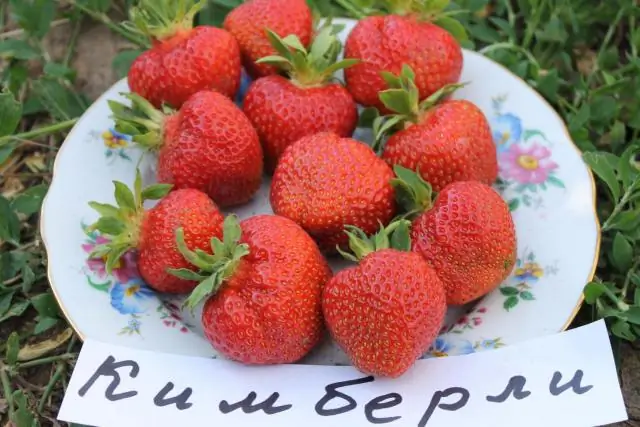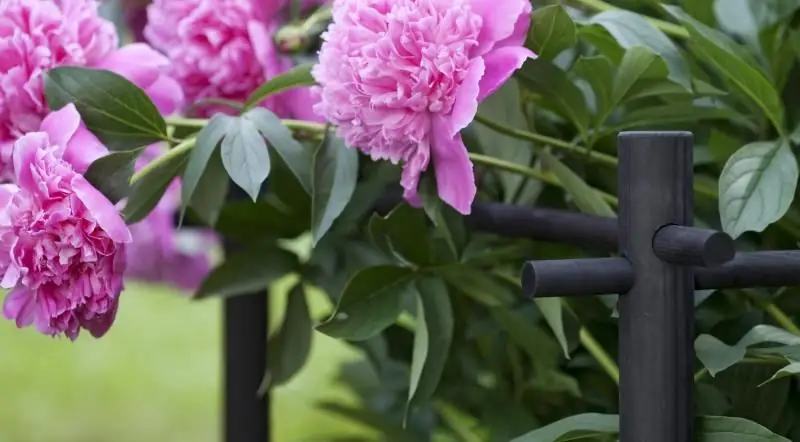
Table of contents:
- Kimberly strawberries: characteristics of an early variety and cultivation features
- Strawberries or strawberries: how to distinguish between these berries?
- Description of Kimberly garden strawberries (Wima Kimberly)
- Landing rules and options
- Kimberly strawberry care
- Reproduction of Kimberly garden strawberries
- Diseases and pests
- How to harvest and preserve crops
- Reviews of gardeners about Kimberly garden strawberries
- Video: Tricks of growing large-fruited strawberries
- Author Bailey Albertson [email protected].
- Public 2024-01-17 22:26.
- Last modified 2025-06-01 07:32.
Kimberly strawberries: characteristics of an early variety and cultivation features

Among the huge variety of modern varieties of garden strawberries (they are used to call them strawberries in Russia) there is a special berry that has a pleasant caramel taste and an early harvest. This is the Kimberley variety, bred by Dutch breeders. Strawberries have many advantages: they are high-yielding, with large and highly aromatic berries ripening several days earlier than other popular early varieties.
Content
-
1 Strawberries or strawberries: how to distinguish between these berries?
1.1 Table: Differences between strawberries and garden strawberries
-
2 Description of Kimberly garden strawberries (Wima Kimberly)
- 2.1 A brief history of the creation of the variety
- 2.2 Yield and ripening dates of Kimberley
- 2.3 Appearance of bushes and berries
- 2.4 Pros and cons of Kimberly variety - table
- 2.5 Kimberly berries in the photo
- 2.6 Video: Kimberley is an early variety with very high yields
-
3 Rules and options for boarding
- 3.1 Planting time of Kimberley seedlings
-
3.2 Landing methods
- 3.2.1 Planting in rows (step by step)
- 3.2.2 Growing Kimberley Strawberries in Tunnels
-
4 Care of Kimberly strawberries
- 4.1 Watering
-
4.2 Fertilization
- 4.2.1 Table: Fertilization mode
- 4.2.2 Video: How to properly care for strawberries
-
5 Reproduction of Kimberley garden strawberries
- 5.1 Antennae
- 5.2 Seeds
-
6 Diseases and pests
- 6.1 Table: main diseases and pests and how to control them
- 6.2 Photo gallery: How to recognize diseases and pests of Kimberley strawberries
- 7 How to harvest and preserve crops
- 8 Reviews of gardeners about Kimberly garden strawberries
- 9 Video: Tricks of growing large-fruited strawberries
Strawberries or strawberries: how to distinguish between these berries?
You can often hear from gardeners that they are growing strawberries. But is it really so? Botanists claim that the large-fruited berry, popularly called strawberries, is actually garden strawberries.
The plant was obtained in the 18th century by French breeders by crossing American strawberry species.
The progenitors of garden strawberry were the Chilean and Virginian species. Cultivated berries were much larger than forest berries and soon became popular among gardeners throughout Europe.
Table: Differences between strawberries and garden strawberries
| Index | Strawberry | Garden strawberry |
| Plant appearance | The bush is tall, with fleshy shoots. Peduncles are higher than foliage, and flowers are smaller than those of garden strawberries. | The plant is squat, the peduncles are hidden under the leaves. |
| Fruit appearance | The berries are small, rounded, resembling a glomerulus. The color of the fruit is uneven. | The berries are conical in shape, with a pointed nose. The fruits are large and evenly colored. |
| Berry flavor | The berries are aromatic and sweet. | The berries taste sour-sweet, with a bright aroma. |
| Pollination method | The plant is dioecious, that is, there are either female flowers or male flowers on the bush. To set fruits, it is necessary to plant one male (pollinator) on five female bushes. | The plant is monoecious (self-fertile). Both female and male flowers grow on one bush, so all the seedlings yield a harvest. |
Description of Kimberly garden strawberries (Wima Kimberly)
A brief history of the creation of the variety
The Kimberly variety (Wima Kimberley) is the property of Dutch breeders. It was obtained by crossing the garden strawberry Chandler and Gorella. The result was a hybrid with an unusual berry flavor (caramel), powdery mildew resistance and spring temperature extremes.

Kimberly has large caramelized berries
Kimberley yield and ripening
The Kimberly Garden Strawberry is a short day plant. This is an early variety. The first berries appear in late May - early June. Fruit ripening can be significantly accelerated by using agricultural technology for growing strawberries in tunnels. With good care, the yield is quite high, up to 1 kg of berries can be harvested from one bush of Kimberly strawberries.
The appearance of bushes and berries
The berries of the Kimberley garden strawberry are large (about 40-50 g), have a pleasant caramel taste and a classic conical shape. They grow smooth, bright red in color. The pulp is a little lighter, it is colored in a pale red hue and has no internal voids. The Kimberly variety is suitable for transportation due to its high density of berries.

Kimberly strawberries are sweet and beautiful berries
The bushes are medium-sized, medium-leafy. The leaf blades are rounded, the petioles are slightly pubescent, and the peduncles are strong and tall. Under the weight of ripe fruits, they do not lean to the ground, which means the berries do not rot. This feature of Kimberly strawberries has become the key to the resistance of the variety to powdery mildew.
Kimberly is a fairly frost and drought tolerant variety. It can be grown practically throughout Russia. But it should be borne in mind that in severe winters the plant can freeze out, therefore, in the northern regions, it needs shelter.
Pros and cons of Kimberly variety - table
| Benefits | disadvantages |
| Drought and frost resistance | The variety is picky about lighting |
| The berries are large, high-yielding variety, can be harvested up to 1 kg per bush | The number and size of fruits are significantly reduced in adverse weather conditions |
| Powdery mildew resistant | It is affected by pests and spotting. |
| Early ripe variety | Only the first berries of the season grow large, then they become smaller |
| Can be grown in a tunnel to speed up the ripening of berries | Taste deteriorates when grown in greenhouse conditions |
Kimberly berries in the photo
-

Berries in a plate - Kimberly strawberries are large and even
-

Strawberries on the palms - Kimberley high yield
-

Strawberries in the garden - The variety practically does not affect powdery mildew.
Video: Kimberly is an early variety with a very high yield
Landing rules and options
The bushes of the Kimberley variety are medium-sized, so when planting, leave 25-30 cm between the plants.
For planting garden strawberries, a well-lit place from all sides is best suited; it should be even or with a slight slope. But the lowlands are not suitable. With excessive dampness, the plant is affected by root rot and blows out in the spring.

Start preparing the strawberry bed in advance
The Kimberley variety requires light but fertile soil. Strawberries grow well on sandy loam or loamy substrate. But to get an excellent harvest of sweet berries, you need to improve the quality of the soil. This is done through simple agronomic techniques.
- Start preparing land for strawberry plantation about two weeks before the planned date of planting seedlings in open ground.
- Dig up the ground thoroughly, remove all rhizomes of weeds.
- Add 1 sq. m of a plot of half a bucket of coarse sand, two buckets of rotted manure, 50 g of urea and 1 tbsp. l. wood ash.
- Embed all nutrients in the ground and level the bed with a rake.
Planting time of Kimberley seedlings
The optimal planting dates for the Kimberley variety are May or August. In the first case, the seedlings of garden strawberries take root well and immediately grow, but you should not wait for the harvest in the first year, the plants planted in spring will begin to bear fruit only in the second year.
When planting in August, the first berries can be harvested next summer, but you should not hesitate with the landing date. The best time is mid to late August.
Planting methods
Garden strawberries can be planted in open ground in rows, as well as in tunnels with a film cover.
Planting in rows (step by step description)
- Dig a trench about 20 cm deep along the ridge 15 cm from the edge.
- For the second row, dig a similar trench 40 cm from the first.
- Moisten the rows.
- Spread the strawberry seedlings 25-30 cm apart.
- Cover the seedlings with soil, place the plants vertically and carefully straighten the roots.
- When sprinkling a bush with soil, make sure that the heart (growth point) remains at the soil level. It should not be too deep or raised.
- Water the plantings liberally with warm water.
- Mulch the soil around the strawberry bushes with humus, dry grass, straw or sawdust.

It is very convenient to care for strawberries planted in rows
Growing Kimberley strawberries in tunnels
A feature of the Kimberley variety is the early (usually June) harvest. But the ripening of the berries can be further accelerated and the fruits of excellent taste can be obtained already in May. For this, strawberries are planted in tunnels.
To grow with this method you will need:
- metal or plastic arcs (you can use special designs for cucumber greenhouses);
- polyethylene film.

Growing strawberries in a tunnel speeds up the ripening of berries
Step by step description of landing:
- Prepare the beds for planting (as described above).
- Plant the strawberries in rows in August.
- Place arcs along the edges, placing them at a distance of about 0.5-0.7 cm from each other.
- In the spring, as soon as the snow begins to melt, cover the arcs with plastic wrap or agrofiber.
- When the temperature rises, open the greenhouse from the ends.
Kimberly strawberry care
Watering
The Kimberly variety is quite drought-resistant. However, don't stress your garden strawberries. Watering she needs regular and abundant.
Water the beds depending on the moisture content of the substrate. On hot, dry days, do this every 2 days, pouring three to five liters of water under the bush. In a rainy season, you do not need to water the strawberries.
Drip irrigation is a very effective method of moisturizing. Installing the system is quite costly, but it will help save gardeners from exhausting work on the site.
Fertilization
Kimberley strawberries require a fairly large amount of nitrogen at the beginning of the growing season (growth) and organic matter during fruiting. Three organic fertilizing is required per season: infusion of mullein or chicken droppings. And also several procedures for the introduction of mineral complex fertilizers.
Table: Fertilization mode
| Period | Necessary feeding |
| In the spring, at the very beginning of the growing season | For 1 sq. m add 50 g of urea and the same amount of wood ash. The fertilizer can be spread over the snow. During its melting, nutrients will enter the ground. |
| Before flowering | Root feeding with a solution of mullein or bird droppings (1 liter per 1 plant). Foliar top dressing with fertilizers for strawberries, for example, Agricola or Ovary (make the solution according to the instructions). |
| After fruiting, late August-early September | Mullein or bird droppings solution (1 liter per 1 plant). You can also feed the strawberries with superphosphate or nitrophosphate, the fertilizer granules should be scattered over the surface of the garden, then loosened and moisten the soil well. |
| End of September | Compost or humus. Cover the strawberry bushes with fertilizer. |
Video: How to properly care for strawberries
Reproduction of Kimberly garden strawberries
Kimberly strawberries can be propagated by tendrils or seeds.
Mustache
- When the rosette, located on the tendril closest to the mother plant, is sufficiently developed, pin it to the ground, and cut off the rest of the tendril.
- By August, when the rosettes are sufficiently rooted, separate the seedlings from the mother bush. Cut them off with a clean knife from the mother liquor, if the antennae have not yet rotted away.
- Dig out rosettes with a root ball of earth.
-
Plant the resulting seedlings on a separate bed for growing, and in the spring (late April-early May) transplant them to a permanent place.

Propagation of strawberries with antennae Whisker reproduction is the most efficient method
Seeds
Purchase seeds for germination from a specialty store or garden center, or prepare them yourself. To do this, you need to choose the most beautiful, largest and healthiest berry with the characteristic features of the variety.
- Cut off the top part from it with a razor, along with the seeds and place on a sheet of paper to dry the pulp.
- Soak the seeds in warm water for a day.
- Prepare a loose turf, sand, and peat substrate. Pour it into a shallow container.
- For germination, strawberry seeds need stratification (imitation of winter). Put a layer of snow on the ground, on which lay the soaked seeds, carefully spreading them with a toothpick. You do not need to fill up the planting with a substrate. The snow will melt and pull the seeds into the ground.
- Cover the container with the planting material with a transparent lid and send it to the refrigerator for stratification.
- After 10-14 days, remove the bowl with seeds from the refrigerator and place in a warm place.
- Moisten the plantings as the top layer dries. Do not allow the soil to dry completely.
- As soon as the strawberry has two true leaves, remove the lid.
- Divide the seedlings into separate containers. It is very convenient to use peat pots for this purpose. Together with them, you can plant strawberry seedlings in open ground without injuring the delicate root system.
- Plant strawberry seedlings in the garden after the threat of return frost has passed.

Peat pots are great for growing garden strawberries from seeds
Diseases and pests
Kimberly strawberries are resistant to powdery mildew, a common disease of berry crops. But this variety can get sick with brown spot. He is also annoyed by:
- strawberry-raspberry weevil;
- nematode;
- spider mite.
To protect plants from pests and diseases, for prevention, they should be periodically treated with infusion of garlic. And in case of illness or insect attack, modern drugs will help you.
Table: main diseases and pests and how to deal with them
| Disease / pest | Symptoms | Treatment |
| Brown spot | Small brown spots appear on the leaves and petioles, which form a white border as they grow. With a strong infection, the leaves wither and dry. Sometimes symptoms can also be observed on fruits (dry, small spots around the seeds on the surface of the berries). | Before budding and after harvesting, spray strawberries with Topaz (according to the instructions) or 1% Bordeaux liquid. |
| Strawberry mite | The sheet is deformed, rolled up. The growth of the bushes is inhibited, and the berries become smaller. | Spray the plants and the soil around them with Aktofit or Fitoverm (make the solution according to the instructions), carry out two processing procedures: before the beginning of fruiting and after harvesting. |
| Raspberry and strawberry weevil | The buds dry and fall off. If you look closely, you can see small bugs on them. | Spray the strawberries with an infusion of tobacco dust and red hot pepper mixed with a soapy solution. Collect weevils by hand daily. To do this, put a white sheet of paper under the bush and shake its plant, destroy bugs. |
| Strawberry nematode | Cuttings grow short, thickened and deformed. Plants become squat, and the leaves curl into a tube. The berries grow ugly and small. | It is almost impossible to get rid of the pest. Dig up the bushes, trying not to leave roots in the ground, burn them. Do not plant strawberries in this place for 5-10 years. |
Photo gallery: How to recognize diseases and pests of Kimberley strawberries
-

Brown spot on strawberries - Kimberly strawberries are susceptible to brown spot
-

Strawberry nematode - Strawberry nematodes make the berries look ugly and small
-

Raspberry and strawberry weevil - Hand picking helps in the fight against insects
How to harvest and preserve crops
The pulp of Kimberly strawberries is quite dense, the fruits are transportable, they can be transported over long distances. If you do not plan to serve the berries immediately to the table, then pick them slightly unripe (with a white tip) and put them in plastic or wooden boxes.
To keep the strawberries fresh for several days, immediately after picking them, send the berries to the refrigerator and leave for a couple of hours until they cool down to a temperature of +2 ° C.

Pick strawberries in the morning after the dew dries
Kimberly berries can also be frozen. They make incredibly aromatic jam or jam. These strawberries will remain intact in the compote.
Reviews of gardeners about Kimberly garden strawberries
Video: Tricks of growing large-fruited strawberries
Everyone is good at Kimberly garden strawberries! If you provide a plant with excellent care, suitable conditions for growth and development, it will certainly delight its owners with large and beautiful berries.
Recommended:
Garden Lilies - Planting And Care, Photo And Video (oriental, White, Tubular)

Features of the species and varieties of garden lilies. Tips for planting lily bulbs. advice on growing and care
Garden Strawberry Variety Tsaritsa - Features, Care And Other Important Aspects + Photo

Description of the garden strawberry variety Tsaritsa. Advantages and disadvantages. Planting, care and reproduction. Disease and pest control. Harvesting. Gardeners reviews
Garden Strawberry Victoria - Features Of The Variety And Important Nuances Of Growing + Photo

Strawberries or strawberries? And also about Victoria over common sense
Chamora Turusi Variety Of Garden Strawberries - Features, Care And Other Important Aspects, The Difference Between Strawberries And Garden Strawberries + Photo

Everything about the Chamora Turusi strawberry variety: from planting and care to picking berries. Productivity, terms of fruiting, reviews of gardeners
Fences For Garden Beds With Your Own Hands - How To Make A Fence For A Front Garden, Flower Garden Or Vegetable Garden, Step By Step Instructions With A Photo

Options for fences for a suburban area. Their pros and cons. How to install a holder for plastic bushes, a flower bed from bottles: step by step instructions. Video
